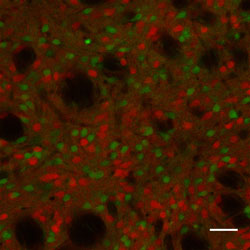Habitual Behavior Modifies Brain Circuits


Mice striatum neurons from the “go” (red) and “stop” (green) pathways. Credit: Kristen Ade, Duke University.
Researchers from Duke University have recently found evidence of brain changes caused by habits. Habitual behavior leaves a mark on certain neural circuits that stimulate the organism to repeat our recurrent practices. The study was published in the journal Neuron.
The dorsolateral striatum (DLS) is a part of the forebrain and has important roles in the reward system and habit formation, but the mechanisms of repetitive behavior and the formation of the related circuits are unclear. The DLS receives inputs that translate into firing of neurons that project information to the basal ganglia. These ganglia are a series of subcortical nuclei with roles in voluntary motor movements, routine behaviors, cognition and emotion. Basal ganglia activity is divided in two pathways that carry opposite information: one stimulates an action, the other stops it.
The researchers trained healthy mice to acquire different levels of addiction to sugar by pressing a lever that delivered sweets. Some mice developed a visibly compulsive behavior: they kept pressing the lever even if no reward was present. The scientists proceded to compare the brains of addicted and non-addicted mice by checking the electrical activity in the basal ganglia.
Fastest “go” pathway activation in addicts
The experiments confirmed that the sugar-addicted mice had an increased basal ganglia activity, both in the “stop” (indirect) and “go” (direct) pathways. The increase in activity in the indirect pathway was totally unexpected, as it had been considered to prevent habitual behavior. The activation pattern was also different for both groups of mice: in addicts, the direct pathway was activated first; in non-addicts, the indirect one was faster. The researchers tried to eliminate the habit from addict mice by rewarding individuals that stopped pressing the lever. Later, they could check that mice that quit the habit had a weaker direct pathway.
It is unclear how these findings would translate into human treatment of bad habits. Targeting the basal ganglia is risky because it has many other functions. For severe addictions, some scientists are currently using a non-invasive technique -transcranial magnetic stimulation (TMS)-, but for simpler habits, behavioral techniques are more common.
Source: Duke
